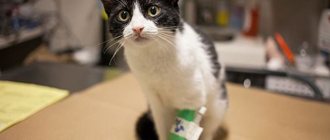12192Administration
Waiting for kittens from a pet is a trembling and responsible event, especially if the cat is preparing to become a mother for the first time. The question of when the kittens of a pregnant cat begin to move worries, perhaps, all owners - after all, this is a sure sign that the pregnancy is proceeding normally and the health of the babies and mother is in perfect order.
On average, the gestation period for kittens is two months. Depending on the breed and size of the animal, as well as some genetic characteristics, these periods can vary from 58 days to 72. The more kittens in the womb, the shorter the duration of pregnancy, the sooner they will begin to move. Accordingly, 1-2 babies will be born a little faster.
Pregnancy in cats: duration, signs and proper care
Pregnancy in cats is a period of anticipation and pleasant excitement.
Like any expectant mother, the kitty needs a certain attitude and care.
Therefore, it is worth collecting as much information as possible in order to take good care of the expectant mother.
Pregnant kitties need extra care and attention
Cats gestation period
To begin with, it is worth deciding what period it is correct to call pregnancy.
Some people think that this time is counted from mating to childbirth . However, it is not.
The gestation period begins when fertilization occurs.
Naturally, in this case, no one can determine with ideal mathematical accuracy how many days a cat’s pregnancy has already been going on.
But this is not scary, later in the article a number of signs will be given by which the owners will be able to clearly understand that it is time to give special attention to their murka and prepare a place for the birth of offspring.
Many sources give different periods of pregnancy, on average it is 9 weeks.
This period can be increased or decreased by a week, which is not a bad thing.
The duration of gestation of kittens depends on the physical condition of the kitty, its breed and age.
It has been noted that short-haired cats like Devon Rex , Abyssinian , Russian Blue and Bombay cats have a shorter gestation period (58-68 days) than long-haired cats like the Neva Masquerade , Siberian and Norwegian cats (62-72 days).
However, if the kitty does not give birth on the 70-72nd day, you need to contact a veterinarian.
It happens that already in the 1st or 2nd week of pregnancy, the kitty becomes more melancholy and thoughtful. She eats less, sleeps more than usual and practically does not want to play
First signs of cat pregnancy
Although it is very difficult to immediately calculate the exact date of conception, quite obvious signs of pregnancy can be observed already on the 20th day after it.
The cat's nipples become enlarged and become bright pink. The skin around them begins to peel off. This is very easy to notice if you put the kitty on its back.
In the third week, an experienced veterinarian can determine the pregnancy of the murka by palpation.
Important! Do not attempt to palpate yourself! This is fraught not only with the death of kittens, but also with serious difficulties with the cat’s health.
An ultrasound scan at a veterinary clinic will help you find out about the number of kittens and their condition.
It happens that already in 1-2 weeks the kitty becomes more melancholy and thoughtful.
She eats less, sleeps more than usual and practically doesn’t want to play.
At 3 weeks pregnant, she may feel nauseous due to hormonal changes.
This is not something abnormal, because pregnant women also often have morning sickness in the first trimester.
After 3-5 days, the vomiting goes away, and the owner can be sure that his pet will soon become a mother.
Cats can also have a false pregnancy, which “goes away” on its own and does not require special treatment.
However, when “substrate” happens often, you need to show the animal to a specialist.
In most cases, cat pregnancy proceeds without complications.
Sexual activity of cats during pregnancy
No matter how many days a cat is pregnant, she may unexpectedly go into heat.
Usually from the very beginning of bearing kittens she behaves calmly.
But it happens that just on the 20-21st day of pregnancy or later, the kitty again begins to ask for cats.
This phenomenon is called superfetation, and it occurs in every tenth cat.
If you allow her to mate with a cat, she can become pregnant a second time with a new father.
The kittens will develop normally in the uterus 3-6 weeks apart.
In this situation, there is a danger that when Murka gives birth to her first kittens, she may have a miscarriage from their second “batch.”
If such a disaster does not happen, then 3-6 weeks after the first birth the second occurs.
It is important here that there are enough nipples and milk for all kittens from both litters.
Sometimes a pregnant cat wants to go for a walk “to the left”
Progress of pregnancy
Now you know how much the cat carries, you can also establish pregnancy, especially in its third week.
Her subsequent kitten-bearing schedule looks like this:
- Weeks 4-6: The growing fruits become so large that you can feel them when you gently press on the cat’s tummy. This study must be carried out very carefully and without sudden movements, which can damage the baby’s amniotic sac and lead to miscarriage.
- In the fifth week, the kitty's tummy becomes very noticeable, it is beautifully rounded. And from the sixth week, especially if Murka is carrying more than 2 kittens, the belly becomes very large - the babies grow quickly. At the sixth week, the cat should begin to produce milk.
During pregnancy, a cat, not only its belly, takes on rounded shapes
- Weeks 7-9: In the seventh week, the uterus fills with fluid, so it is difficult to determine by palpation how many kittens will be born. If you are really curious, it is better to do an ultrasound. But during this period the fruits are already so large that you can feel their heads with your palm. During this period, the kitty begins to behave restlessly and look for a place to give birth. This is the right time to introduce her to the box you have prepared.
- At week 9, the cat calms down, becomes inactive and even a little detached. Her nipples protrude noticeably and her mammary glands become enlarged. The vulva may discharge a little clear or white mucus.
- 3-4 days before the onset of birth, the kitty can suddenly become active and follow its owner everywhere. Her body temperature drops to 37°C.
Depending on the period of pregnancy, the cat behaves differently: sometimes it sleeps all day, sometimes it begins to be active.
Important! If a pregnant cat urgently demands that you be with her, this is not a whim. This behavior may be a consequence not only of the fact that she perceives you as her parent and patron.
The cat has a good sense of what its birth will be like - problematic or not.
And if the animal urgently demands your presence, arm yourself with all the necessary auxiliary items, as well as patience, and stay close to the murka.
It is forbidden to give a pregnant cat any medicine, except in some exceptional cases when she is sick with something. And then, in such a situation, be sure to consult a veterinarian
It’s good if the kitty was dewormed and vaccinated before mating.
It is forbidden to give a pregnant cat any medicine, except in some exceptional cases when she is sick with something.
And then, in such a situation, be sure to consult a veterinarian.
In general, caring for a pregnant cat involves providing her with rest and sufficient, well-chosen nutrition.
Even if your kitty eats dry food, it is worth consulting with your veterinarian which natural products should be included in her menu.
There is no need to give vitamins, since you have already increased the portions of your kisuni.
If her diet contains everything she needs, why oversaturate her body with all sorts of additives?
Moreover, such an overdose is fraught with defects and deformities in kittens. The exception is the recommendation of a veterinarian.
Caring for a pregnant cat involves providing her with rest and sufficient, well-chosen nutrition.
About a week before the expected birth, it is worth slightly reducing the amount of food you give your cat.
This is done so that newborn kittens are a little smaller and the birth is easier.
Don’t worry, this will not affect the final size of the offspring, because their dimensions are determined genetically.
Knowing how long pregnancy lasts in cats will help protect the expectant mother from danger.
For example, in the seventh week, the kitty's center of gravity, for obvious reasons, changes, but the cat may not be particularly aware of this, still trying to climb onto the cabinet.
However, due to an impaired sense of balance, she may fall, harming herself or the kittens.
Make sure that during the period from the 7th week until birth, climbing on mezzanines and other heights becomes impossible for your kitty.
Make sure that during the period from the 7th week until birth, climbing on mezzanines and other heights becomes impossible for your kitty. During this period she needs peace
Also, in the last weeks of pregnancy, it may be difficult for your kitty to maintain personal hygiene and reach her private parts.
Help her keep clean and wipe these areas with a damp cloth.
It would be good to give the cat an ultrasound at 8-9 weeks. This will allow you to know exactly the number of kittens and be ready for delivery.
It is imperative to find out where the veterinary clinic is located, working around the clock, and write down its telephone numbers.
This information will be useful if insurmountable difficulties arise during childbirth.
Possible difficulties during pregnancy
Due to various factors - poor nutrition, physical trauma, uterine infection, hypothermia or overheating - a cat may have a miscarriage.
Most often this happens at 4-5 weeks of pregnancy. If you suspect a miscarriage, call your veterinarian immediately.
Dead fruit must be removed as quickly as possible before putrefactive processes begin.
Take care of the place for childbirth in advance. The cat and future kittens should feel comfortable there
So, what does it take for a cat’s pregnancy and birth to be successful? Right!
First you need to arm yourself with the necessary information, and then take the right actions to care for your cat.
And the kitty will definitely delight you with a litter of cute fluffy lumps with beady eyes.
Source: https://kot-pes.com/beremennost-u-koshek-srok-priznaki-i-gramotnyj-uxod/
Childbirth is approaching
After about 9 weeks, the baby’s body is fully formed
, and they are ready to be born. The gestation period for each cat breed is different, but in general it can differ by 5-7 days, up or down.
If 2-3 weeks before the onset of birth, babies begin to actively move, then a few days before the important date, their mobility may decrease - this is completely normal, you should not be afraid of this phenomenon.
The cat's behavior changes: it may suddenly lose its appetite, become restless, it meows a lot and looks for a place to give birth. She produces milk.
Usually cats cope well with childbirth on their own, however, to be on the safe side, it is important to have first aid supplies for the animal and the phone number of a trusted veterinarian on hand. Don't leave your cat alone if she's close to giving birth.
The birth of kittens: how to help a cat during childbirth (memo for cat owners…
An attentive owner will never miss the onset of labor in his cat. If the relationship between the owner and the cat is established, then the cat will immediately come to the owner at the first signs of labor.
If a cat is afraid of its owners and fears for the life of its future offspring, at the first signs of labor it will try to hide where you cannot reach it.
Therefore, you need to think about how your cat’s birth will go from the first day a breeding cat appears in your home.
A properly socialized, educated cat, living in affection, love and understanding, listens to the owner during childbirth, is less nervous, and thus childbirth is easy for both the owners and the mother cat.
British cats usually carry kittens for 65-69 days. Pregnancy is diagnosed 21 days from the average day of mating - the papillae become slightly swollen and reddened. Kittens usually begin to move 3-4 weeks before birth. A day before giving birth, the mother cat's tummy sag.
Preparing for childbirth
How to help a cat during childbirth?
Prepare in advance for childbirth. For this you will need:
- The nest can be an exhibition cage made of dense material (the most convenient option) or a spacious box (in a small, cramped one, the cat can crush the baby with its body). Make sure that there is a warm mattress at the bottom and cover it with medical oilcloth, which, after the birth is over, replace with a diaper (preferably from a baby flannel - the kittens will be comfortable on it and it will not cling with claws)
- Washed and ironed cloths for wiping and massaging newborn kittens. It is most convenient to use old terry towels for this.
- Medicines - gamavit, oxytocin (in a “human” pharmacy), calcium gluconate, traumatine, Vaseline oil (in case the kitten gets stuck in the birth canal), brilliant green for cauterizing the umbilical cord.
- Scissors (it is better to put them in a jar with potassium permanganate or ignite them)
- Jar for afterbirth
- A heating pad (or preferably a small electric heating pad)
- Syringes (preferably insulin, with a thin needle)
- Phone number of a veterinarian (preferably more than one), just in case.
Read more about preparing for childbirth.
First signs of labor
A week before giving birth, the cat becomes restless - she licks herself more often, rummaging through cabinets in search of a cozy nest. On the day of birth, she may meow pitifully and pester with caresses.
A “plug” comes out; it can come out within a few hours, or it can come out several days before the birth.
Obstetrics
Childbirth begins with contractions, weak at first - when the cat’s cervix opens and the kittens “line up”, taking the necessary positions. During this period, a cat (especially a primiparous cat) may begin to frequently run to the litter box.
Now is the time to give your cat injections:
- Gamavit injections. Gamavit is a complex of biologically active substances, which, in this case, works as a stimulator of the birth process. It is injected into the withers, subcutaneously, in an amount of 1 ml, 1-2 times during childbirth.
- If the cat is weak, hyperexcited, afraid, screaming, then inject her with the homeopathic drug Travmatin - it anesthetizes the birth process and regulates the strength of pushing. It is also injected into the withers, the dosage is the same - approximately 1 ml (depending on the size of the cat).
- Calcium gluconate injections. During pregnancy, the calcium content in a cat's body decreases greatly (it goes into the structure of the kittens' skeletons and milk production), which can lead to inertia of the uterus during childbirth and even to an acute nervous disease - eclampsia. Calcium gluconate is injected intramuscularly into the hind leg, always in a warmed state (to body temperature), carefully and slowly inserting a needle into the muscle - 1 ml.
The amniotic fluid recedes and pushing begins - wave-like contractions of the abdominal muscles, pushing the kitten out. Usually, the kitten goes in a bubble and, under no circumstances, should the cat be allowed to bite through it. The kitten can come out in 2 positions - head first (diver position) or hind legs forward.
If the kitten has a hard time coming out, you can help him. If the kitten walks with its legs, wait until the body is pushed out as much as possible and tightly grasp the body and legs with a gloved hand or a rag and hold it so that they do not go inside again when the fight ends.
Next, wait for the next attempt and try to stretch the body as far as possible, be careful with the birth of the head, it is the largest, and the cat must give birth to it itself. If the kitten walks with its head, then you should wait until the cat gives birth to its head and only then grab the head and shoulders (or by the scruff of the neck) and then independently pull out the body.
During the period when the pushing stops, stop pulling the kitten, just hold it so that it does not go back into the birth canal.
Take the born kitten in your hand, placing it vertically, and break the bubble above its nose, free it from the membranes and cut the umbilical cord at a distance of approximately 3 cm, having previously pushed its contents back into the tummy with your fingers, and burn it with brilliant green.
Then take the kitten’s body in your hands, clasping the head with your thumb and forefinger, shake it like a thermometer, holding the head, clean the mucus from the mouth and nose with a soft napkin (or gauze), open its mouth slightly and take a light breath into the nose to open the lungs.
Rub the baby with a soft cloth, lightly massage his chest and give it to the cat so she can lick him - this is also a massage. If the cat is experienced and has already given birth, she can adopt the kitten herself - gnaw the umbilical cord and lick it.
If the kitten is weak, born without signs of life, we rub it thoroughly again, massage the chest, it helps a lot to put it in a warm (40-50 degrees) bath for a second or two. A placenta comes out behind the kitten, one or two should be given to the cat so that she can eat them - they contain substances that stimulate labor and the flow of milk to the mammary glands, make sure that the number of placentas matches the number of kittens.
Now - about oxytocin. This hormonal drug has saved more than one cat from caesarean section. But it must be handled very carefully, it causes strong contractions of the uterus and, if the kitten is in the wrong position, it can jam the entire birth process, again leading to a caesarean section.
It is used in cases where labor pains are weak and the cat cannot push the kitten out of her.
But it can be injected only after the birth of the first kitten, when it is obvious that the uterus is already open or when the kitten’s head or paws are already visible in the loop, in this case, injecting oxytocin (at the withers - 0.2-0.3 ml) gives a positive The result is that after 2-3 attempts the kitten comes out. If labor is weak, the injection can be repeated after 20-30 minutes.
After the birth of the first kitten, as a rule, the cat rests - place the born baby on her nipples.
When repeated attempts begin, put the born babies aside in a warm place (preferably on a heating pad) so that the cat does not crush them.
The normal period between the birth of kittens is considered to be up to 12 hours; after this period the situation can be considered pathological. In general, each cat can have its own, specific break in the birth of kittens, sometimes they are born almost immediately, one after the other, after 20-30 minutes, and sometimes the cat gives birth to each next one after 4-5 hours, and oxytocin injections have no effect .
So there is no need to worry too much about this, the situation should cause concern when there are strong attempts for a long time, but the kitten does not come out. In this case, you need to call the veterinarian - placenta accreta may be present or the kitten may be in the wrong position; a mummified (dead) kitten may stand in the birth canal and jam the exit for the rest of the living kittens.
When the birth is over, give the cat something to drink - water or low-fat cream or warm milk, and inject the cat with oxytocin - once, 0.2 ml - this causes cleansing of the uterus and an additional flow of milk.
In the future, watch the cat - pink discharge may come from the uterus, but it should not smell bad and be bright red or contain impurities of pus, the cat should not be depressed. The discharge may last 3-7 days, and then it will disappear, otherwise, be sure to contact your veterinarian.
Check whether the cat has enough milk for all kittens (weigh the babies - kittens should gain weight at least 10g per day) and whether the cat licks them well (if their butts are dirty, massage their tummy and wipe them with a damp cloth yourself) - young cats often “forget” this duty.
If everything is good, the kittens don’t squeak, sleep a lot, gain weight well, the cat looks happy and purrs.
Source: https://www.sunny-cat.ru/?article=1635-rozhdenie-kotyat-kak-pomoch-koshke-pri-rodah-pamyatka-dlya-vladelcev-plemennyh-koshek
When should you call the veterinarian?
Pregnancy is a natural state for a healthy cat. Most likely, the birth will be successful and without human intervention. But there are a number of symptoms that indicate a serious threat to the animal’s life:
- The cat has not touched food for more than a day.
- Body temperature rose above 39 degrees or, conversely, fell below 38.
- The animal is breathing heavily and does not move away from the water bowl.
- The cat does not stop licking thoroughly, trying to get rid of the liquid (black, gray, pink, green, brown or yellow) secreted from the loop.
There is no need to wait for all the signs to appear. If you notice any of the items on the list, make an appointment with your veterinarian immediately. Delay can cost the life not only of future offspring, but also of your pet.
Remember that it is your responsibility, as the owner, to take care not only of the physical, but also of the moral well-being of the expectant mother. A cat's needs are not limited to food and sleep. Now you have another important mission - to organize the leisure time of the pot-bellied lady. Try to entertain your cat more often with moderately active games and walks. A future woman in labor has no need for excess weight - it will only hinder her. Do not deprive the animal of attention and affection, because during this period the cat is especially vulnerable and attached to humans.
Video on the topic
A cat reaches sexual maturity approximately in the seventh month of life. True, there have been cases of the onset of estrus from four months in some Siamese and Oriental cats.
Pregnancy in cats - weekly calendar
If you have a healthy purebred cat and are considering breeding it, you will need to spend some time learning about the process before you get started.
It is important for you, as a responsible owner, to establish whether there is actually any demand for kittens of this species in order to avoid increasing the already constantly growing cat population, because you are not going to breed kittens just to witness the miracle of birth.
Even if you have established that you can easily find homes for your future kittens, cat breeding is not something you should rush into.
As with finding a suitable sire for your potential new kittens, you will need to spend a significant amount of time determining whether breeding your cat would be appropriate in terms of her age, health and lifestyle.
You will also need to make sure that you can adequately care for your cat during pregnancy and adapt to her changing needs.
The gestation period (the period between conception and birth) in cats typically lasts about 63 days, although it can last several days longer in some breeds, such as the Siamese. As with human births, cats do not have a rigid schedule, so you should be prepared for the potential of a few days between your cat giving birth early or late.
Here you will find a calendar for your cat's pregnancy from conception to birth, week by week.
Week 1: days 1-7
Early in your cat's pregnancy, after mating and fertilization, for a couple of weeks you cannot be sure that she is actually pregnant. However, if your cat is fertile and has had contact with a male cat, then it is very likely that kittens have been conceived.
Cats can carry kittens from even multiple males if they come into contact with more than one male at the approximate time of conception! During the first week after mating, the male's sperm will reach and fertilize the cat's eggs, which in turn will begin moving to the uterus, where the rest of the pregnancy will develop.
Week 2: days 8-14
At the beginning of the second week, fertilized eggs moving into the uterus will implant (immerse) into it and thereby begin the process of development and growth of the kittens.
3 and 4 weeks: days 15-28
During the third week, the implanted embryos begin to develop their organs, which causes a surge of hormones in the pregnant cat. During this period, you may also notice that your cat's nipples may darken and become somewhat swollen.
During the third or fourth week, your cat may begin to suffer from nausea, which may result in her refusing to eat her usual food, and may also lead to vomiting, and not necessarily in the first half of the day! This is completely normal, but if the vomiting continues and is severe, it would be best to consult your veterinarian. Your veterinarian will be able to confirm pregnancy using an ultrasound scan around day 18 after conception. At the end of the fourth week, the veterinarian should be able to palpate the abdomen and definitively confirm the pregnancy manually, if you have not already had an ultrasound at this point.
After the fourth week, you should not lift your pregnant cat as this may harm the kittens.
Week 5: days 29-35
At the fifth week, an experienced breeder or veterinarian will be able to feel the kittens through the abdomen, and will even be able to tell you how long they are gestating.
Week 6: days 36-42
The sixth week of pregnancy is the period when you will notice a significant increase in your cat’s appetite, she will begin to eat “in reserve”, since she will have to feed kittens. Allow your cat to eat as much food as she wants and make sure she eats a high-quality, nutritious diet.
Also, at this time, you will be able to see and feel the movement of the kittens in the cat's stomach.
Week 7: days 43-49
By the seventh week, your cat's pregnancy will be very obvious and your cat will have a very round appearance!
Week 8: days 50-56
By the eighth week, you will be able to clearly feel the kittens' stomachs. Your cat's nipples will become large and prominent, and your cat will spend a lot of time grooming herself.
She may begin to shed belly hair, which is a natural process that sometimes accompanies pregnancy and is not a cause for concern. Her fur will grow back as soon as she gives birth! Her appetite may decrease somewhat at this point, as the growing kittens will reduce the capacity of the abdomen.
Your cat will also start looking for a suitable place to nest, so you should help her with this, a regular box or basket will be quite suitable places.
About a week before giving birth, your cat may begin to produce milk, and you may even be able to see it on the tips of her nipples, which means your cat's body is preparing to give birth and nurse future kittens.
Week 9: days 57-63
Growing kittens will continue to increase in size, and your cat may develop a slight discharge from the vulva, which may also have a reddish tint. At this time, you should be ready to give birth at any moment! If your cat appears restless, seeks reassurance, or settles into the nesting box for a long period of time, it means that birth is very close!
Week 10: days 64 onwards
If your cat is past the tenth week of pregnancy, you should expect to give birth any day now. Some cat breeds, especially Siamese, usually give birth no earlier than the tenth week. However, if by the end of the week you still haven't seen any signs of labor approaching, you should consult your veterinarian to make sure your cat is okay.
Source: https://petstime.ru/article/beremennost-u-koshek-kalendar-po-nedelyam
Why don't kittens move?
If at a certain stage of pregnancy a cat’s kittens begin to move, it means that everything is going smoothly, and the birth of babies is not far off.
However, there are often cases when the owners of a pregnant cat panic: her belly is already large and round, but the kittens are not moving! Is this dangerous and why does this happen?
It is often possible to notice how kittens move only a day or two before the onset of labor. This happens if the pet has a fairly well-fed physique or there are not very many babies inside - then they will be located quite high, under the sternum.
In addition, in different cats the moment of the beginning of movement may come later or earlier - perhaps it is worth waiting a week or two, especially since it is possible to determine the exact date of conception only if the mating was planned.
And yet, in rare cases, it happens that a cat’s big belly does not indicate pregnancy at all, but a serious pathology of the internal organs. Therefore, if there is any doubt, it is better to show the animal to a veterinarian and have an ultrasound examination done.
A cat reaches sexual maturity approximately in the seventh month of life. True, there have been cases of the onset of estrus from four months in some Siamese and Oriental cats.











